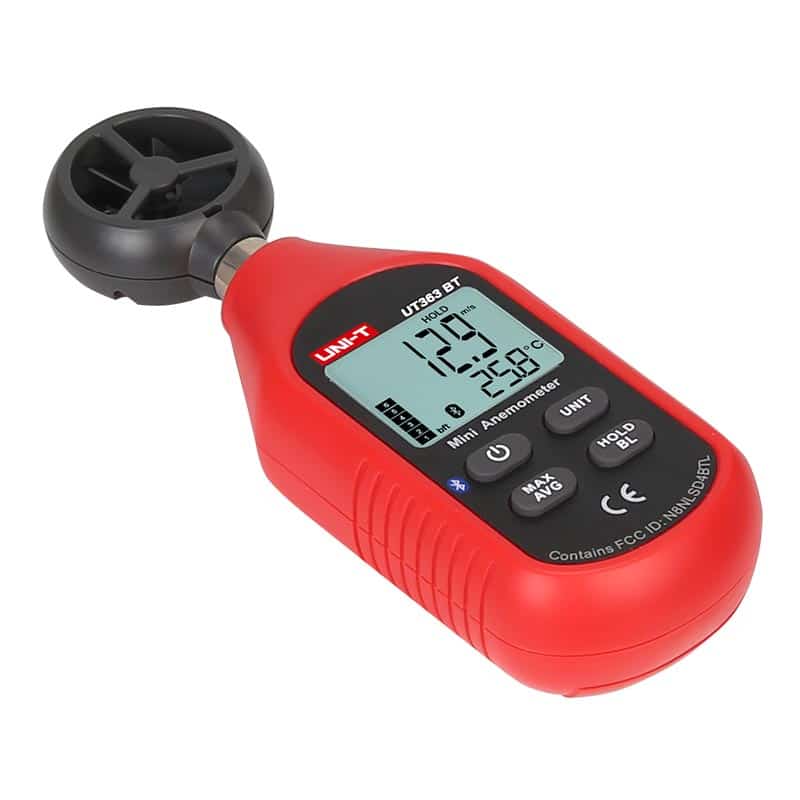Comprehending Various Types of Anemometers for Numerous Applications
Comprehending Various Types of Anemometers for Numerous Applications
Blog Article
All You Required to Know Concerning Anemometers: Just How They Function, Why They Issue, and Where to Make use of Them
Anemometers, however often forgotten in the realm of scientific instruments, play a vital function in different areas, providing important understandings into wind speed and airflow patterns. As we dig right into the complexities of anemometer technology, we will discover the internal functions of these gadgets, their importance, and the key considerations when choosing the best anemometer for certain applications.

Anemometer Basics
A necessary tool made use of to gauge wind speed and direction, the anemometer plays a critical function in meteorology and numerous industries. An anemometer generally includes three or 4 cups that rotate in the wind, a vane that aims into the wind, and sensing units to track the rotations or activities. By calculating the turnings or activities over a details amount of time, the anemometer can determine wind rate. The vane assists identify wind direction by directing into the wind, providing important information for weather condition projecting, air travel, maritime procedures, ecological surveillance, and wind power applications.
There are various kinds of anemometers offered, including cup anemometers, vane anemometers, hot-wire anemometers, and sonic anemometers, each with its distinct features and applications. Cup anemometers are commonly used for standard wind rate measurements, while vane anemometers are chosen for directional measurements. Hot-wire anemometers are suitable for reduced airspeeds, and sonic anemometers are excellent for high-precision dimensions in study and industrial settings. Comprehending the fundamentals of anemometers is vital for precise wind data collection and evaluation across various fields.
Concepts of Anemometer Operation
Building on the foundational understanding of anemometer basics, the concepts of anemometer operation illuminate the technicians behind wind speed and instructions dimensions. Mug anemometers, for circumstances, have 3 or more cups that capture the wind, triggering them to rotate much faster as the wind rate boosts. Hot-wire anemometers rely on a warmed cable that cools down as wind passes over it, with the rate of cooling figuring out the wind speed.
Relevance of Anemometers
The importance of anemometers in weather forecasting and different markets can not be overemphasized. Anemometers play a critical duty in determining wind rate and direction, offering essential data for weather condition projecting, climate research studies, environmental surveillance, and air travel operations. Meteorologists count on anemometers to collect exact wind data, helping them comprehend weather condition patterns, predict storms, and issue timely warnings to the general public. In industries such as construction, farming, eco-friendly energy, and maritime procedures, anemometers are made use of to maximize procedures, make certain security, and enhance efficiency. For example, wind ranch drivers make use of anemometers to evaluate wind conditions and maximize power production from wind generators. In the maritime industry, anemometers Recommended Reading aid ship navigating by offering real-time wind details to captains, helping them make educated choices to guarantee secure voyages. On the whole, anemometers are essential devices that contribute significantly to safety and security, performance, and informed decision-making in weather forecasting and a variety of sectors.
Applications Throughout Numerous Industries
Applications of anemometers cover across varied markets, showcasing their versatility and utility past weather forecasting. In the renewable power market, anemometers play a critical duty in analyzing wind conditions for wind ranch positionings, ensuring optimal energy production. Industries like construction and mining utilize anemometers to monitor wind rates, important for security procedures, particularly when operating at heights or in open-pit mines where solid winds can position risks. Anemometers are also indispensable in the aeronautics market, aiding pilots in comprehending airspeed and wind direction for safe take-offs and touchdowns. The maritime market take advantage of anemometers for ship navigating, assisting sailors prepare for weather changes and adjust routes accordingly. In farming, anemometers aid farmers in handling crop spraying by providing real-time data on wind speed to stay clear of drift. Furthermore, anemometers locate applications in heating and cooling systems to optimize air movement and enhance power efficiency in structures. The diverse use instances of anemometers highlight their value across numerous markets, highlighting their important role in enhancing operational safety and performance (anemometer).

Choosing the Right Anemometer for Your Requirements
Choosing check my blog the appropriate anemometer customized to your details needs is necessary for getting exact wind rate and direction measurements. When selecting an anemometer, think about factors such as the desired application, needed dimension variety, ecological conditions, and preferred functions. For general objectives, a mug anemometer appropriates for determining wind rate, while a vane anemometer offers wind instructions information. Hot-wire anemometers are excellent for low airspeed measurements, and ultrasonic anemometers supply high precision and sturdiness.

Final Thought
In verdict, anemometers play an Visit Website essential function in gauging wind speed and direction throughout different industries. It is important to think about the value of anemometers in order to make informed decisions when picking the most ideal tool for measuring wind conditions.
There are different types of anemometers available, consisting of mug anemometers, vane anemometers, hot-wire anemometers, and sonic anemometers, each with its distinct functions and applications. Mug anemometers are typically used for basic wind rate measurements, while vane anemometers are chosen for directional dimensions. Hot-wire anemometers are suitable for low airspeeds, and sonic anemometers are perfect for high-precision dimensions in research study and commercial setups.Building on the fundamental understanding of anemometer fundamentals, the concepts of anemometer procedure clarify the mechanics behind wind rate and instructions dimensions. For basic objectives, a cup anemometer is appropriate for gauging wind speed, while a vane anemometer offers wind direction information.
Report this page